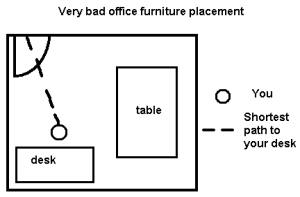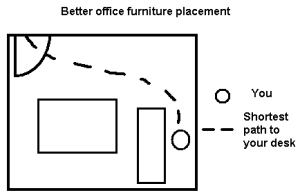In an office, the struggle for space is every employee’s battle. The amount of space you call your own is directly proportional to the power you wield over your enemies, ne coworkers. Win the ground war and you can win any other battle in the office.
themeat.org has developed the theory of Defensive Office Furniture Placement. By adhering to these rules, you can be assured that anyone who fucks with your turf will have a very hard time doing it, provided they have the balls to do it in the first place. Most of these rules apply to people in offices, but can be adapted to cubicles or other work areas.
Annexing terroritory
The best defense is a good offense, so take every opportunity to expand your meager land holdings. Try getting yourself projects that will require large amounts of space to complete. Whenever an office nearby becomes available, ask for permission to store extra equipment/papers/lackeys there. Also be sure to accumulate plenty of extra boxes of paper, computers, and pieces of furniture in the event you need to expand. You’ll never be able to keep the extra space you aquire unless it looks occupied.
Proper furniture placement
If you have a computer in your office, your first priority is to protect the contents of your monitor at all costs. No floor plan is complete unless your monitor faces away from the entry to your office. For open space work areas, your monitor should face away from any managers’ offices since your coworkers won’t care if you’re slacking (because they’re slacking too). This is troublesome for cubicles, so first try to put yourself between the monitor and any peering eyes over the cubicle walls.
When arranging your office, you have two priorities. First, choose a floor plan to maximize the amount of time it takes for a manager to approach and get around your desk. Second, make the furniture placement as intimidating as possible. Here are some examples to clarify the point.

A naive way to arrange your office would be to stick the desk next to the wall and the table in the remaining space. But notice how easily a manager can sneak behind you to see what your doing. Furthermore, when someone is talking to you in your office, you must turn around because the only seating space is behind you.

Here’s an even worse example. Anyone who walks by your door can see exactly what you’re doing on your computer without even entering your office. And this still doesn’t solve the issue of turning around to talk to anyone in your office.

A better idea is to put your desk as far away from the door as possible with you facing the door. Not only can you see anyone who enters, but nobody can see what you’re doing unless they walk behind you. But this still isn’t the best solution.

The best idea is to put your desk against the wall with the door, making a very long path to walk around behind your desk. While this office isn’t very intimidating, there’s not much intimidating you can do with just a desk and a table.

If you have two desks, you can make a very intimidating office by barracading yourself in at one end of the room. The large desk area gives the impression you actually need that large a working space to do your tasks. The problem here is to fill the empty space with something so it doesn’t look like you’re occupying half an office, such as a bookcase or another desk.
Fortifying your position
Besides the overt defensive manuevers you can pull off with furniture placement, you can intimidate anyone into submission the moment they step into your office with a little help from your surrounding environment.
- Get a chair that has a very high back. Make yourself look more important than you really are.
- Keep your office very hot or very cold. Dress appropriately to make yourself look comfortable in that environment.
- If you’re near a window, position yourself so that anyone who talks to you sees the window directly behind you. Any other distractions you can put behind yourself can’t hurt either. Absolutely do this if your window faces traffic or any other moving distractions.
- Put small, playful objects on your desk. If they move and make noise, all the better. Buy those little silver balls that hang from strings and bounce back and forth. Make sure they’re always going.
The defensive cubicle
Cubicles were the evil invention of a manager in some corporation somewhere who wanted to find a way to spy on the workers while demoralizing them. Your goal, in the defensive cubicle, is to avoid both of these and maybe even turn the tables on your managers at the same time.
Come up with a subtle communication method with your fellow cubicle dwellers to alert each other when a manager approaches. Use things like chair adjustments, staplers, and computer beeps to signal what manager it is and which direction he/she is coming from. But it has to be office noises only – no coughs or sneezes or other human noises. Managers are dull, but not stupid, so use an innovative communication system to avoid suspicion.
In a cubicle or small office environment, you can overhear every conversation. Pay attention to these. If a coworker of yours (who you want to help) is trapped in a bad conversation with another coworker or manager, call his/her phone and talk to them. Save your coworkers from bad conversations and they’ll repay the favor to you some day.


furniture is misspelled in your article’s graphics.